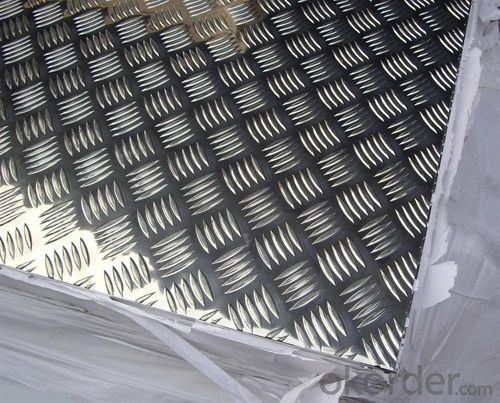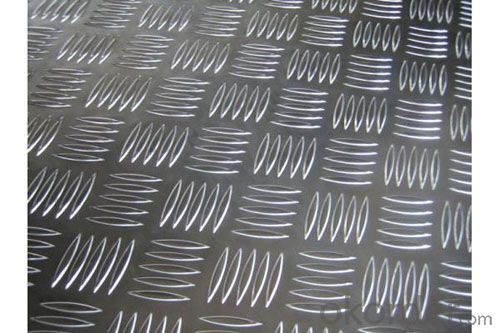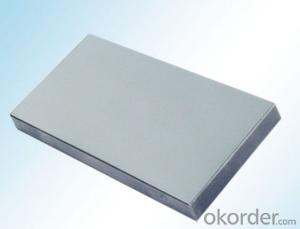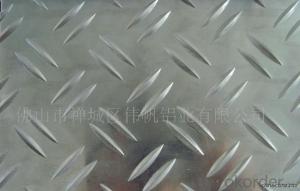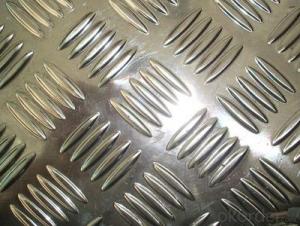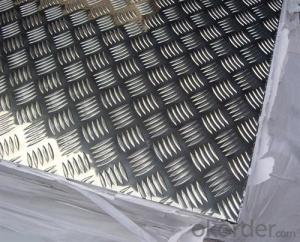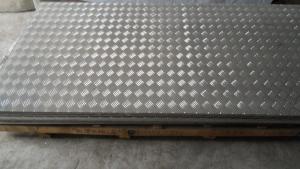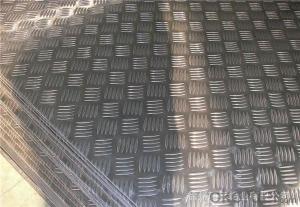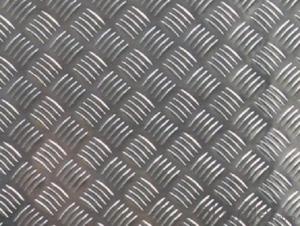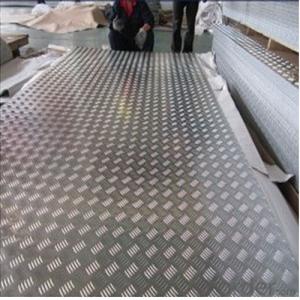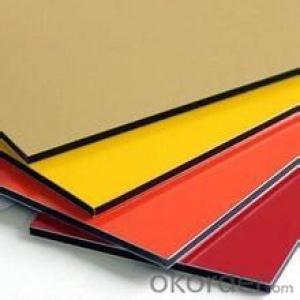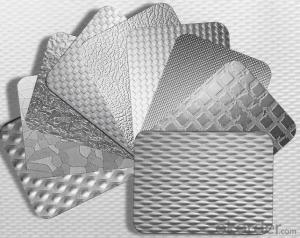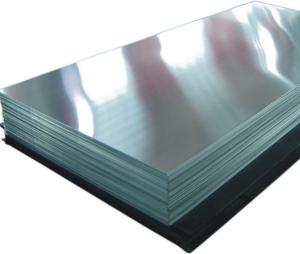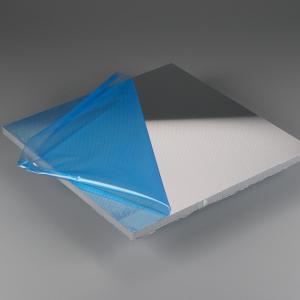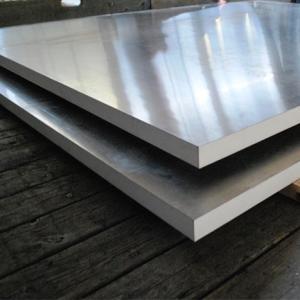Aluminum Sheets Home Depot Embossed Aluminum Sheet 5 Bars Treading Plate
- Loading Port:
- China main port
- Payment Terms:
- TT OR LC
- Min Order Qty:
- 5 m.t
- Supply Capability:
- 5000 m.t/month
OKorder Service Pledge
OKorder Financial Service
You Might Also Like
Specification
1. Description of Embossed Aluminium Sheet 5 Bars Treading Plate
Alloy: 1050, 1060, 1100, 3003, 3005, 3105, 5052, etc
Thickness: 0.2mm~20mm
Temper: H14, 18, 24, 26, 32
Width: 10mm- 1500mm
2. Application of Embossed Aluminium Sheet 5 Bars Treading Plate
(1).Interior: wall cladding, ceilings, bathrooms, kitchens and balconies, shutters, doors...
(2).Exterior: wall cladding, facades, roofing, canopies, tunnels,column covers , renovations...
(3).Advertisement: display platforms, signboards, fascia, shop fronts...
3. Feature of Embossed Aluminium Sheet 5 Bars Treading Plate
*Such coil is specially designed to replace aluminum ingot, due to the high export tax of aluminum ingot, the coil has better price than ingot.
*This type of coil can fit customer's remelting furnace just like ingot, no need to make any change to the production line that was previously used for ingot. The standard coil size and weight is very suitable for the feed gate of furnace.
*This type of coil causes less material wastage than ingot when remelted.
*Our coil is made directly from ore, no need to go though the ingot making process, quality is much better than other suppliers who use ingot scrap to make coil.
Be free from Oil Stain, Dent, Inclusion, Scratches, Stain, Oxide Dicoloration, Breaks, Corrosion, Roll Marks, Dirt Streaks and other defect which will interfere with use
4. Certificate:
SGS and ROHS(if client request, paid by client), MTC(plant provided), Certificate of Origin(FORM A, FORM E, CO), Bureau Veritas and SGS (if client request, paid by client), CIQS certificate
5. Image of Embossed Aluminium Sheet 5 Bars Treading Plate
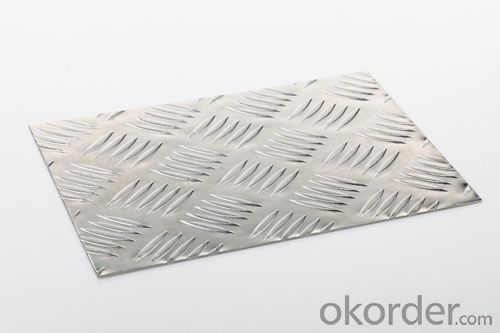

6. Package and shipping of Embossed Aluminium Sheet 5 Bars Treading Plate
eye to Sky
eye to wall
with wood pallet (wooded case also available)
7. FAQ
1) What is the delivery time?
Dpends on actual order, around 20 to 35 days
2)What is the QC system:
We have QC staff of 20 persons and advanced equipment, each production is with MTC traced from Aluminum ingot lot.
3) What market do you mainly sell to?
- Q: Can aluminum sheet be used for aerospace structural components?
- Yes, aluminum sheet can be used for aerospace structural components. Aluminum is commonly used in the aerospace industry due to its desirable properties such as low density, high strength-to-weight ratio, and excellent corrosion resistance, making it suitable for various structural applications in aircraft and spacecraft.
- Q: What are the common sizes of aluminum sheet?
- The sizes of aluminum sheets commonly differ based on specific requirements and industry applications. However, the market offers some standard sizes that are readily available. These sizes typically vary in thickness from 0.025 inches to 0.125 inches and are offered in different widths and lengths. Among the common width options are 36 inches, 48 inches, and 60 inches, while the length can range from 96 inches to 144 inches. Furthermore, smaller sizes like 12 inches by 24 inches or 24 inches by 24 inches can also be found, which are frequently utilized for smaller projects or crafts. It should be noted that specialized aluminum sheet suppliers can provide custom sizes as well.
- Q: Can aluminum sheets be used for boat hulls?
- Yes, aluminum sheets can be used for boat hulls. Aluminum is a popular material choice for boat hulls due to its lightweight nature, high strength-to-weight ratio, and excellent corrosion resistance. Aluminum sheets are often used in boat construction to create hulls that are durable, sturdy, and capable of withstanding harsh marine environments. The versatility of aluminum allows for various fabrication techniques, making it suitable for different types of boats, including recreational boats, fishing boats, and even commercial vessels. Moreover, aluminum hulls require less maintenance compared to other materials, which makes them a cost-effective option for boat owners.
- Q: How does the alloy composition affect the mechanical properties of aluminum sheet?
- The mechanical properties of aluminum sheet are significantly influenced by its alloy composition. These properties include tensile strength, yield strength, elongation, hardness, and fatigue strength, among others. To begin with, the overall strength of the aluminum sheet is greatly affected by its alloy composition. Aluminum alloys are commonly mixed with elements like copper, manganese, magnesium, and silicon to enhance their mechanical properties. These alloying elements form solid solutions or precipitates within the aluminum matrix, resulting in a significant increase in material strength. For example, the addition of copper to aluminum forms a solid solution that enhances the sheet's tensile strength and yield strength. Furthermore, the ductility and formability of the aluminum sheet are also impacted by its alloy composition. Some alloying elements, such as magnesium and silicon, can reduce the ductility of aluminum alloys. This reduction in ductility makes the sheet more susceptible to cracking or fracturing when subjected to stress. Conversely, certain alloying elements can improve the formability of aluminum sheet, making it easier to shape or bend without cracking. Moreover, the resistance to corrosion and heat of aluminum sheet is influenced by its alloy composition. For instance, aluminum alloys with a high magnesium content, such as the 5000 series, exhibit excellent corrosion resistance and are commonly used in marine applications. Additionally, specific aluminum alloys are developed for high-temperature applications, with alloying elements like copper and zinc enhancing their heat resistance. Finally, the microstructure of aluminum sheet is affected by its alloy composition, which in turn affects its mechanical properties. Different alloy compositions can result in various microstructural features, including grain size, grain boundaries, and phase distribution. These microstructural characteristics can impact the sheet's strength, hardness, and fatigue resistance. In conclusion, the alloy composition plays a crucial role in determining the mechanical properties of aluminum sheet. Manufacturers can tailor the sheet's properties to meet specific requirements, such as strength, ductility, formability, corrosion resistance, and heat resistance, by carefully selecting the appropriate alloy composition.
- Q: What are the properties of anodized aluminum sheets?
- Anodized aluminum sheets are highly desirable for a variety of applications due to their distinct properties. Firstly, they possess a protective oxide layer on their surface, which enhances their resistance to corrosion. This layer is formed through an electrochemical process called anodization, wherein the aluminum sheet is treated with an electric current in an acid electrolyte solution. Consequently, anodized aluminum sheets become more durable and capable of withstanding harsh environments, making them suitable for outdoor use. Another notable property of anodized aluminum sheets is their improved scratch resistance. Through the anodization process, not only is a protective layer created, but the surface of the aluminum also becomes hardened, rendering it more resistant to scratches and wear. This property proves particularly advantageous in applications where frequent handling or abrasive conditions are involved. Moreover, anodized aluminum sheets can be manufactured in a wide range of colors. The anodization process enables the integration of dyes or pigments into the oxide layer, resulting in an array of vibrant color options. This aspect makes anodized aluminum sheets highly popular in architectural and decorative applications, as they can be customized to meet specific design requirements. Additionally, anodized aluminum sheets possess excellent thermal and electrical conductivity. The process of anodization does not significantly impact these inherent properties of aluminum. Consequently, anodized aluminum sheets can efficiently dissipate heat and conduct electricity, making them well-suited for applications such as heat sinks, electronic enclosures, and electrical components. To sum up, anodized aluminum sheets possess enhanced corrosion resistance, improved scratch resistance, a wide range of color options, and excellent thermal and electrical conductivity. These properties render anodized aluminum sheets a versatile and durable material for various industries and applications.
- Q: Is it suitable to use aluminum sheets in outdoor settings where they will be subjected to weather conditions?
- <p>Yes, aluminum sheets can be used for outdoor applications, even when exposed to weathering. Aluminum is a durable and corrosion-resistant material, which makes it suitable for outdoor use. It does not rust like iron or steel and can withstand various weather conditions. However, it's important to use aluminum alloys specifically designed for outdoor use, and to apply protective coatings or finishes to enhance its resistance to weathering and extend its lifespan.</p>
- Q: Are aluminum sheets suitable for lightweight structures?
- Yes, aluminum sheets are suitable for lightweight structures due to their low density and high strength-to-weight ratio.
- Q: Are aluminum sheets prone to warping?
- Under certain conditions, aluminum sheets may be susceptible to warping. Unlike steel, aluminum is a relatively soft metal, making it more prone to bending or distorting. However, the extent of warping in aluminum sheets depends on various factors, including sheet thickness, alloy composition, temperature exposure, and applied stress levels. Thinner aluminum sheets have less structural integrity, making them more prone to warping. Conversely, thicker sheets are more resistant to warping due to their increased rigidity. The specific alloy composition of the aluminum sheet also affects its susceptibility to warping. Warping can occur due to temperature fluctuations. High temperatures cause aluminum to expand, and without proper support, it may bend or warp. Similarly, rapid cooling causes contraction, leading to warping. The level of stress applied to aluminum sheets can contribute to warping. Excessive bending, pressure, or unevenly distributed loads can deform the sheet. To minimize warping, it is crucial to handle aluminum sheets carefully, provide adequate support during temperature changes, and avoid applying excessive stress. Additionally, using thicker sheets or selecting alloys with higher tensile strength helps reduce the risk of warping.
- Q: Are aluminum sheets suitable for decorative screens?
- Yes, aluminum sheets are suitable for decorative screens. They are lightweight, durable, and can be easily customized into various shapes and designs. Additionally, aluminum's corrosion resistance makes it suitable for both indoor and outdoor applications, making it a popular choice for decorative screens.
- Q: How does the formability of aluminum sheet vary with different alloys?
- Variations in chemical composition and mechanical properties result in significant differences in the formability of aluminum sheet among different alloys. To enhance specific characteristics like strength, corrosion resistance, and formability, aluminum alloys are typically combined with elements such as copper, manganese, magnesium, and zinc. Aluminum alloys like the 1xxx series (pure aluminum) and the 3xxx series (manganese alloyed) are highly formable and commonly used for deep drawing applications. These alloys can be shaped into complex forms without cracking or tearing. In contrast, alloys with higher strength properties, such as the 2xxx series (copper alloyed) and the 7xxx series (zinc alloyed), generally have reduced formability. Although these alloys are often used in structural applications where strength is crucial, they require careful handling and processing to avoid defects during forming. Alloys in the 5xxx series (magnesium alloyed) offer a good balance of formability and strength. They are widely used in industries like automotive and aerospace, as they can be easily formed into different shapes while providing sufficient strength and corrosion resistance. It's important to note that the formability of aluminum sheet is not solely determined by the alloy composition. Other factors such as sheet thickness, forming temperature, and the specific forming process employed (e.g., deep drawing, bending, stretching) also influence formability. These factors interact with alloy properties to affect the formability characteristics of aluminum sheet. Therefore, careful selection of the appropriate alloy and process parameters is essential to achieve the desired formability for specific applications.
Send your message to us
Aluminum Sheets Home Depot Embossed Aluminum Sheet 5 Bars Treading Plate
- Loading Port:
- China main port
- Payment Terms:
- TT OR LC
- Min Order Qty:
- 5 m.t
- Supply Capability:
- 5000 m.t/month
OKorder Service Pledge
OKorder Financial Service
Similar products
Hot products
Hot Searches
Related keywords


